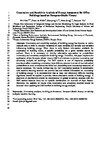Uncertainty and Sensitivity Analysis of Energy Assessment for Office Buildings based on Dempster-Shafer Theory
| dc.contributor.author | Tian, W | |
| dc.contributor.author | de Wilde, Pieter | |
| dc.contributor.author | Li, Z | |
| dc.contributor.author | Song, J | |
| dc.contributor.author | Yin, B | |
| dc.date.accessioned | 2018-08-27T15:49:08Z | |
| dc.date.issued | 2018-10-15 | |
| dc.identifier.issn | 0196-8904 | |
| dc.identifier.issn | 1879-2227 | |
| dc.identifier.uri | http://hdl.handle.net/10026.1/12198 | |
| dc.description.abstract |
Uncertainty and sensitivity analysis of building energy has become an active research area in order to consider variations of input variables and identify key variables influencing building energy. When there is only limited information available for uncertainty of building inputs, a specific probability for a given variable cannot be defined. Then, it is necessary to develop alternative approaches to probabilistic uncertainty and sensitivity analysis for building energy. Therefore, this paper explores the application of the Dempster-Shafer theory (DST) of evidence to conduct uncertainty and sensitivity analysis for buildings. The DST method is one of imprecise probability theories to allow combining uncertainty from different sources in terms of interval-valued probabilities in order to construct the belief and plausibility (two uncertainty measures) of system responses. The results indicate that the DST uncertainty analysis in combination with machine learning methods can provide fast and reliable information on uncertainty of building energy. It is recommended that at least two inherently different learning algorithms should be applied to provide robust simulation results of building energy. A spectrum of distributions should be implemented in global sensitivity analysis with the DST method because there are no specific distributions for intervals of input factors. Moreover, the stability of results from uncertainty and sensitivity analysis should be assessed when applying the DST method in building energy analysis. | |
| dc.format.extent | 705-718 | |
| dc.language | en | |
| dc.language.iso | en | |
| dc.publisher | Elsevier | |
| dc.subject | Uncertainty analysis | |
| dc.subject | Building performance | |
| dc.subject | Dempster-Shafer theory | |
| dc.subject | Sensitivity analysis | |
| dc.subject | Machine learning | |
| dc.title | Uncertainty and Sensitivity Analysis of Energy Assessment for Office Buildings based on Dempster-Shafer Theory | |
| dc.type | journal-article | |
| dc.type | Journal Article | |
| plymouth.author-url | https://www.webofscience.com/api/gateway?GWVersion=2&SrcApp=PARTNER_APP&SrcAuth=LinksAMR&KeyUT=WOS:000447102100055&DestLinkType=FullRecord&DestApp=ALL_WOS&UsrCustomerID=11bb513d99f797142bcfeffcc58ea008 | |
| plymouth.volume | 174 | |
| plymouth.publication-status | Published | |
| plymouth.journal | Energy Conversion and Management | |
| dc.identifier.doi | 10.1016/j.enconman.2018.08.086 | |
| plymouth.organisational-group | /Plymouth | |
| plymouth.organisational-group | /Plymouth/Faculty of Arts, Humanities and Business | |
| plymouth.organisational-group | /Plymouth/REF 2021 Researchers by UoA | |
| plymouth.organisational-group | /Plymouth/REF 2021 Researchers by UoA/UoA13 Architecture, Built Environment and Planning | |
| dcterms.dateAccepted | 2018-08-22 | |
| dc.rights.embargodate | 2019-9-19 | |
| dc.identifier.eissn | 1879-2227 | |
| dc.rights.embargoperiod | Not known | |
| rioxxterms.versionofrecord | 10.1016/j.enconman.2018.08.086 | |
| rioxxterms.licenseref.uri | http://www.rioxx.net/licenses/all-rights-reserved | |
| rioxxterms.licenseref.startdate | 2018-10-15 | |
| rioxxterms.type | Journal Article/Review |


